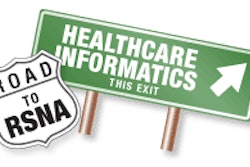CHICAGO - Should a U.S. academic radiology practice participate in the "meaningful use" initiative? An academic hospital with a program in place could provide significant benefits, but without it, there will be hurdles, according to a Sunday afternoon refresher course at the RSNA annual meeting.
In spite of its reputation as a healthcare informatics trendsetter, the radiology department at Brigham and Women's Hospital in Boston did not jump on the bandwagon in 2011 to launch its meaningful use program. Rather, it was to the advantage of the radiology department to wait for the hospital to begin the initiative, explained Dr. Ramin Khorasani, associate professor of radiology at Harvard Medical School and vice chair of Brigham's radiology department.
Although the U.S. Department of Health and Human Services (HHS) is not making it easy for radiologists to participate in its national electronic health record (EHR) adoption initiative, Khorasani strongly encourages them to do so. The American College of Radiology (ACR) estimates that 85% of all radiologists qualify for the program. It is a national initiative designed to improve healthcare delivery for both patients and caregivers alike, to increase patient safety, to decrease healthcare costs, and although not specified by HHS or any of its agencies, to drag the practice of medicine into the electronic era of the 21st century.
"The meaningful use program is directionally correct and has accelerated adoption of EHRs across the country, for better or for worse," he said. "As radiology practitioners, we've been at the forefront of healthcare innovation."
Unless an institution is not implementing a meaningful use program, Khorasani recommends that academic radiologists endorse and attest to meaningful use. Echoing a comment made by Dr. Keith Dreyer, PhD, vice chair of computing and information sciences at Massachusetts General Hospital, earlier in the course, Khorasani emphasized that meaningful use isn't going away. Any radiology department that doesn't join the program will start to be financially penalized in 2015.
"You have to make a decision about when and how to use EHRs, so you're just pushing the inevitable farther and farther out," Dreyer said. "You'll be out of the game, plus you'll be facing penalties."
From Khorasani's perspective as an academic radiologist, what's important is to leverage the initiative being undertaken by the parent hospital, and make the hassles of meeting meaningful use rules the "payment" for gaining access to patient clinical information that radiologists have been requesting for decades.
For academic radiologists, it's important for a hospital to have a meaningful use program. Reasons to postpone implementation include a hospital not having an EHR that has been officially certified for use, a hospital not having a meaningful use program, or a hospital not allocating appropriate resources to support the program. Such resources include a program administrator, designated IT staff, an IT lead and physician lead, processes defined and in place, change management attestation services available, measurement tool software purchased (ideally dashboard-driven), and necessary funds budgeted for training, implementation, and routine operations.
Khorasani recommends that academic radiology departments piggyback on their hospitals' meaningful use program because much of the work will already have been done. There are 15 core measures for stage 1. Three can be excluded by radiologists and five should be centrally handled by a hospital's IT department, leaving only seven for the radiology department to deal with. The clinical quality measures (CQM) requirements can be the ones used by the hospital. Brigham and Women's selected very standard quality measures that are being implemented by all providers affiliated with the hospital: diabetes screening, blood pressure control, and smoking cessation. The data for these CQMs are already populated in the EHR by the time a patient enters a radiology department.
The radiology department at Brigham and Women's Hospital has implemented a very robust program that runs in parallel with the hospital's program. It is administered by Khorasani and a full-time staff member hired specifically to manage the program.
The program was funded from the anticipated financial revenue of $44,000 per radiologist over a five-year period of time. For Brigham's radiology department, this is expected to be at least $5 million. The steering committee at the hospital, which includes all heads of its departments, decided that a portion of any of the funds received would be spent on IT enhancements, such as those that help the department achieve meaningful use.
For the radiology department, this translated into annual operating expenses of about $150,000, and the investment of $100,000 in software to manage the meaningful use program. The radiology department will be allocated 19% of the incentive payments, individual radiologists will receive 33%, and the remainder will be given to the hospital.
Radiologists who attend training programs receive $1,000, as long as they agree to have the hospital serve as proxy for their attestation. This $1,000 investment alleviates the potential problem of motivating individual radiologists to sign up on their own. To motivate them to reach the stage 1 requirements by December 30, 2012, they are given an additional $3,000 payment.
This strategy has worked. In August 2012, no radiologists had attested; several days ago, 78 out of 85 who qualified had attested. The remaining seven will be persuaded to comply because if they do not, the radiology department will lose a considerable amount of incentive payments. The plan is to implement a financial penalty from base pay contracts, which Khorasani said tends to get the attention of his colleagues.
The $100,000 was spent to create a meaningful use dashboard monitoring system and a semiautomated escalation process to enforce compliance. Radiologists at Brigham and Women's are only required to personally submit information about a patient's allergies and problems. Other than these two lists, all other lists are managed by administrative and clerical staff of the radiology department.
The software is programmed to create alerts if any required EHR data being collected for the program are missing for a patient scheduled for a radiology exam. The front desk staff will generate a form for a patient to complete, and this information is given to the meaningful use program administrator to enter.
If a radiologist does not meet the 80% threshold requirement of a problem list, this will be highlighted in an end-of-the-month report prepared for each individual radiologist. Khorasani routinely reviews these, and he intervenes when necessary. He showed an example in which one of his colleagues had reached the 77.8% level.
"We asked this radiologist to review recent cases to identify problems that might have been overlooked and then enter them, which can be done retroactively," he said. "In this case, it wouldn't take more than a few patients to meet the quota."
Dreyer made a point of showing how ambiguous many of the stage 1 rules still are as they relate to radiologists, even though a 1,100-page document update of stage 1 published in September by HHS clarified some issues. One of these relates to the definition of an office visit. For radiologists, there is no question that interventional radiologists have patient encounters. The revised stage 1 rule explained that a minimum consultative service, such as interpreting an electrocardiogram, could qualify to delete the patient from the total number of patients from which "threshold" percentages are generated. This also could hold true for interpreting a diagnostic exam.
The department made a very simple decision, Khorasani said. It classified every exam interpreted on the Brigham and Women's PACS network as being a patient encounter.
"We felt that if reading a CT or MRI is considered a ‘minimal consultative service,' this might be the position taken by the organization that addresses our invoices and our contracts," he said. "The thought of this makes us nervous, even though the policy we have implemented will create very large threshold denominators."
But is this the right decision? Or will it create more work for the department? Time will tell. There are no data, examples, or facts yet to analyze.
Khorasani and Dreyer both emphasized that whatever policies a department establishes for its meaningful use program, they must be documented and updated. "In six years or so, you won't know why you did what you did if you get audited," cautioned Dreyer.
Radiology departments in hospitals that don't meet the requirements outlined for having a viable meaningful use program might be wise to wait at least a year, Khorasani suggested. Software vendors are working hard to develop products, and later adopters may be able to move faster.
"The longer you wait, the more likely it is that solutions will be available to make the process easier," he said.
Should a radiology department wait until it would start being penalized (1% in 2015, increasing in 1% increments to 5% in 2019)? Such a decision is so financially specific to an individual department that an answer couldn't be given. Instead, attendees at this standing-room-only refresher course were advised to begin their financial analyses; DoYouMU.com, a free tool designed for radiology practices and departments, is one place to start.



















